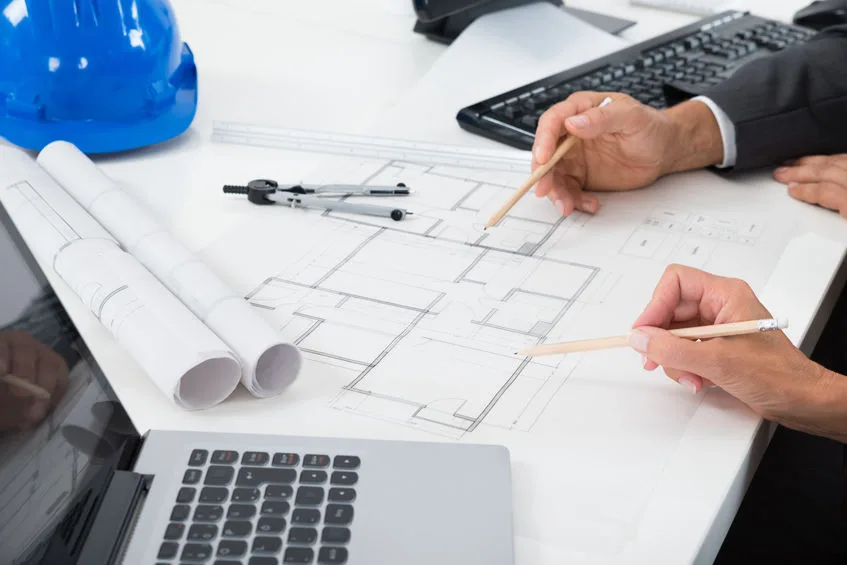Architect Tips for Designing Contemporary Residential Spaces
Architect Tips for Designing Contemporary Residential Spaces
Blog Article
Comprehending the Diverse Job Paths Available for Aspiring Architect
As an ambitious Architect, you have a world of career courses waiting for you. Each course uses one-of-a-kind obstacles and chances to apply your creative thinking and technological knowledge. Whether you're attracted to conventional design or the nuances of lasting design, there's a particular niche that straightens with your passions. Understanding these diverse alternatives can form your expert trip, yet which direction will you pick to explore first?
Standard Architecture: Designing Buildings and Structures
Typical design focuses on designing buildings and structures that blend functionality with aesthetic allure. As you discover this area, you'll value the elaborate balance between kind and objective. You'll discover to attract motivation from historical designs, integrating aspects like balance, products, and workmanship. Your layouts can show cultural heritage, showcasing regional traditions while satisfying modern-day requirements.
You'll establish skills in composing, model-making, and website evaluation, allowing you to visualize and connect your ideas efficiently. Engaging with customers, you'll require to recognize their vision and translate it into viable styles.
In addition, developing codes and sustainability practices are essential in your work, ensuring your structures are environmentally friendly and secure. As you grow in your profession, you'll find opportunities in property, business, or perhaps restoration jobs, each offering special challenges. Welcoming standard style leads the way for a satisfying profession that pays tribute to the past while shaping the future.
Urban Preparation: Forming Communities and Public Spaces
As an ambitious Architect, you can play an important role as a city organizer, changing just how neighborhoods communicate and operate. By utilizing community involvement approaches, you'll ensure that homeowners have a voice in shaping their environment. Plus, incorporating sustainable layout concepts will aid produce rooms that not only fulfill today's requirements but likewise secure the future.
Role of Urban Planners
While lots of could consider architects as the sole visionaries behind structures, metropolitan planners play a necessary duty fit the wider landscape of neighborhoods and public spaces. They examine land use, zoning regulations, and community requires to create sustainable environments that improve lifestyle. By collaborating with numerous stakeholders, you'll help create parks, transport systems, and houses that advertise social interaction and access. Urban planners also concentrate on ecological considerations, ensuring that growths integrate eco-friendly areas and support biodiversity. Your knowledge in spatial style and area dynamics permits you to imagine future development while maintaining social heritage. In this critical duty, you'll straight influence just how individuals experience their surroundings, making every job a possibility for favorable adjustment.
Neighborhood Engagement Strategies
Reliable area interaction methods are important for metropolitan planners to guarantee that the voices of citizens are heard and valued in the planning process. To promote purposeful discussion, you ought to prioritize open online forums and workshops where area members can express their ideas and issues. Usage studies and social networks to get to a broader audience, making certain varied perspectives are consisted of. Collaborating with neighborhood organizations can enhance trust and help with deeper links. It is essential to give clear info concerning decision-making processes and suggested jobs, permitting homeowners to feel enlightened and equipped. By actively integrating and listening feedback, you'll develop areas that mirror the area's needs, eventually leading to more effective and sustainable metropolitan settings. Welcome transparency and continual discussion for long lasting effect.
Sustainable Design Concepts
When creating city spaces, integrating sustainable style principles is essential for producing atmospheres that prosper both ecologically and socially. Take into consideration incorporating environment-friendly spaces, like parks and yards, to improve biodiversity and boost air quality.
Creating with water conservation in mind is likewise key-- think of rainfall gardens and permeable surfaces to handle stormwater. Including neighborhood members during the preparation process guarantees that the rooms you develop satisfy their demands and encourage social interaction. By accepting these concepts, you'll add to dynamic, sustainable metropolitan landscapes that profit every person.

Landscape Architecture: Developing Lasting Outdoor Environments
As you check out landscape architecture, you'll find essential style principles that develop gorgeous and functional outdoor areas. Lasting practices play an essential role in making sure these atmospheres grow while reducing environmental influence. And also, you'll locate a selection of occupation chances that enable you to make a genuine distinction in how people engage with nature.
Design Principles in Landscape
Understanding style principles in landscape style is important for developing sustainable outdoor settings that balance with nature. You'll need to ponder aspects like proportion, scale, and balance to ensure your designs feel cohesive and inviting. Incorporating indigenous plants not only improves biodiversity yet additionally lowers water usage, making your landscape durable. Consider the circulation of room and how people interact with it; paths and seating locations must welcome exploration and relaxation. Furthermore, focus on seasonal modifications, developing with products that enhance the environments year-round (Architect). By focusing on sustainability and aesthetic appeals, you can create exterior rooms that enrich the area and promote wellness. Welcoming these concepts will set a strong structure for your job in landscape style.
Lasting Practices Review
Lasting techniques in landscape style not only concentrate on aesthetic appeals yet likewise prioritize ecological health and source conservation. By integrating native plants, you boost biodiversity and lower the demand for chemical fertilizers and pesticides. Executing effective irrigation systems aids conserve water and decreases runoff, shielding nearby communities. You can design areas that promote soil health, such as using organic products and exercising permaculture concepts. Furthermore, integrating eco-friendly framework, like rain gardens and permeable sidewalks, aids in stormwater monitoring and decreases urban warmth. You contribute to a healthier world and give areas that cultivate area link when you produce exterior atmospheres with sustainability in mind. Eventually, these methods ensure your layouts benefit both people and the setting for several years ahead.
Job Opportunities Expedition
With a solid foundation in lasting methods, landscape style supplies a variety of career paths that permit you to make a meaningful impact on the atmosphere. Urban organizers usually collaborate with landscape architects to produce environment-friendly spaces in city setups, boosting city livability. If you're enthusiastic about education, consider becoming a landscape design educator, motivating future generations.
Lasting Design: Focusing on Eco-Friendly Practices
As you explore your occupation in design, welcoming green practices can establish you apart in an affordable area. Lasting style concentrates on producing buildings that minimize ecological impact while boosting resident wellness. By including renewable materials, energy-efficient systems, and lasting structure methods, you'll add to a greener future.
Beginning by obtaining expertise of eco-friendly accreditations like LEED or BREEAM, which can reinforce your qualifications. Consider exactly how natural light, ventilation, and thermal efficiency can enhance layout. Team up with engineers and environmental specialists to innovate remedies that lower waste and preserve resources.
Do not more helpful hints fail to remember the value of area involvement-- interesting regional stakeholders can influence styles that harmonize with the atmosphere. As clients significantly prioritize sustainability, your expertise in environmentally friendly practices will certainly not just attract jobs however likewise fulfill your passion for responsible architecture. Welcome this essential facet of the occupation, and enjoy your profession prosper.
Historical Conservation: Shielding and Bring Back Social Heritage
While you begin on your architectural trip, consider the vital duty of historical preservation in keeping our cultural heritage. This field concentrates on the protection and remediation of substantial structures, websites, and frameworks that inform the stories of our past. By engaging in historic preservation, you'll help secure the building legacy that shapes area identification.
As a historical conservation Architect, you'll analyze historical value and assess the problem of structures. You'll function closely with preservationists and historians to assure authentic restoration techniques are utilized. This job course permits you to blend creativity with research study, allowing you to design solutions that value initial materials and craftsmanship.
Your job not just adds to sustainability by reusing existing buildings however additionally promotes a feeling of pride within communities. Accepting this course will certainly help you end up being a guardian of history, preserving the stories and visual appeals that enhance our lives.
Interior Architecture: Enhancing Indoor Spaces
Historic conservation and indoor design both share a commitment to enhancing the built environment, but they focus on different aspects. While historic preservation stresses keeping a structure's historical and cultural worth, interior design absolutely nos in on enhancing indoor spaces for capability and appearances.
As an ambitious Architect, you'll find that interior architecture permits you to blend creativity with technological skills. You'll make rooms that not just look excellent yet likewise promote convenience and performance. This area involves recognizing how light, shade, and materials connect within a room, influencing mood and use.
You'll work on numerous jobs, from household homes to business workplaces, making certain that each setting meets the requirements of its residents. By focusing on individual experience, you can transform interiors right into useful and motivating rooms, making a substantial influence on exactly how people engage with their environments. Welcome the possibility to improve indoor atmospheres and form the method individuals live and function.
Industrial Design: Combining Capability With Aesthetic Appeals
Industrial layout plays a crucial role in developing items that flawlessly blend aesthetic appeals with capability, ensuring that what you make use of day-to-day is not just aesthetically appealing but likewise sensible. As an ambitious Architect, you can involve on your own in this area, concentrating on developing whatever from furniture to consumer electronic devices. Your job involves recognizing customer demands, materials, and manufacturing processes, allowing you to create ingenious remedies that enhance everyday experiences.
In industrial layout, you'll commonly work together with marketing experts, producers, and designers, ensuring that your styles are not only beautiful yet also practical. You'll discover to balance type and feature, focusing on functionality without giving up design. By sharpening your skills in laying out, 3D modeling, and prototyping, you'll be well-equipped to bring your ideas to life. This job path provides a vibrant environment where imagination satisfies usefulness, making it a gratifying choice for designers interested in shaping the items of tomorrow.
Regularly Asked Questions
What Educational Certifications Do I Need to Come To Be an Architect?
To become an why not look here engineer, you'll require a specialist level in design, normally a Bachelor's or Master's. In addition, you'll need to complete a teaching fellowship and pass the Architect Registration Evaluation to exercise lawfully.
Are There Qualification Needs for Different Building Job Paths?
Yes, there're certification needs for various architectural paths. Architect. You'll require to pass tests, full internships, and occasionally pursue specialized training, depending upon your selected emphasis, like landscape architecture, urban style, or historic preservation
What Software Skills Are Necessary for Engineers Today?

How Can I Gain Practical Experience While Researching Style?
You can gain sensible experience by interning at building companies, joining design competitions, offering for area projects, or teaming up with schoolmates on real-world projects. These possibilities boost your skills and develop important connections in the market.
What Task Opportunities Exist Outside Traditional Style Firms?
You can explore different job opportunities outside typical design firms, like urban preparation, interior decoration, landscape architecture, construction management, property growth, or even functions in sustainability consulting. Each deals check this special obstacles and rewards.
Whether you're attracted to traditional architecture or the nuances of lasting layout, there's a specific niche that aligns with your rate of interests.When creating metropolitan rooms, integrating lasting design concepts is vital for developing environments that grow both ecologically and socially.As you discover landscape architecture, you'll uncover crucial style concepts that create gorgeous and practical outside areas.Recognizing design principles in landscape design is crucial for creating lasting exterior settings that balance with nature.In industrial style, you'll typically collaborate with suppliers, marketing professionals, and designers, guaranteeing that your designs are not just lovely yet also possible.
Report this page